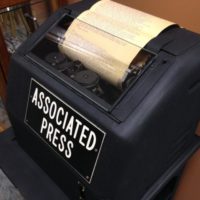I recall visiting the radio station where my father worked and standing in front of the Associated Press teletype, entranced by the endless stream of words. Who was typing? Where were they? Did they ever stop?
Years later, as a young man, I got a job at the station and came to depend on the AP “wire.” It was our only link to real-time (I’m not sure that phrase even existed in 1972) news and information from outside our little town. The daily newspaper was tossed on the doorstep every afternoon (or you could get the Memphis paper a day late). The three national TV networks gave us a half-hour of national news each evening.
 Our radio station didn’t have a national news network (until 1974) so we relied on the Associated Press newswire for just about everything throughout the day. During a live “board shift” we would dash to the AP teletype (in the transmitter room) and “rip the wire” which involved tearing a long strip of printed wire copy into piles of news, weather, sports, entertainment news, etc. If the paper jammed or the ribbon broke, we missed whatever was fed. If something the AP considered urgent was fed, an alarm bell on the teletype sounded.
Our radio station didn’t have a national news network (until 1974) so we relied on the Associated Press newswire for just about everything throughout the day. During a live “board shift” we would dash to the AP teletype (in the transmitter room) and “rip the wire” which involved tearing a long strip of printed wire copy into piles of news, weather, sports, entertainment news, etc. If the paper jammed or the ribbon broke, we missed whatever was fed. If something the AP considered urgent was fed, an alarm bell on the teletype sounded.
A radio station had to have a wire service. Without it they were limited to playing records and reading local news and school lunch menus. The AP knew this and charged accordingly. Thousands of dollars a year. Contracts were for five years. But there was no alternative.
In 1984 I left the radio station to take a job managing The Missourinet, a statewide news network originating from Jefferson City, Missouri. I worked for (parent company) Learfield Communications for the next 28 years. One of the more interesting projects I worked on was the creation of a low-cost alternative to the Associated Press. We called it Learfield Data (later, Learfield Newswire).
I worked on this (along with bunch of other people) for a dozen years from the late ’80s through 2000. At one time we had 300 subscribers. When the World Wide Web became a reality in the mid-90s it was clear the days of wire services were numbered. Road kill on the Information Highway. You can read (PDF) the story of how it began and ended here: Learfield Data

 Our radio station didn’t have a national news network (until 1974) so we relied on the Associated Press newswire for just about everything throughout the day. During a live “board shift” we would dash to the AP teletype (in the transmitter room) and “rip the wire” which involved tearing a long strip of printed wire copy into piles of news, weather, sports, entertainment news, etc. If the paper jammed or the ribbon broke, we missed whatever was fed. If something the AP considered urgent was fed, an alarm bell on the teletype sounded.
Our radio station didn’t have a national news network (until 1974) so we relied on the Associated Press newswire for just about everything throughout the day. During a live “board shift” we would dash to the AP teletype (in the transmitter room) and “rip the wire” which involved tearing a long strip of printed wire copy into piles of news, weather, sports, entertainment news, etc. If the paper jammed or the ribbon broke, we missed whatever was fed. If something the AP considered urgent was fed, an alarm bell on the teletype sounded.